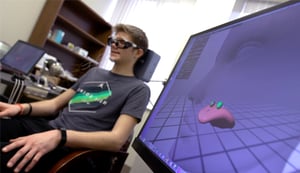 Let's face it, sometimes we give it our all and just don't see the results we desire. When you or your child has been working forever on a sound like "r" or "s" and the progress isn't happening, the results can be disappointing. I get it-- having one little speech sound error hang around comes with a whole host of problems. Whether it is jokes at your expense, anxiety meeting new people, or even bullying, you would do anything to make a change.
Let's face it, sometimes we give it our all and just don't see the results we desire. When you or your child has been working forever on a sound like "r" or "s" and the progress isn't happening, the results can be disappointing. I get it-- having one little speech sound error hang around comes with a whole host of problems. Whether it is jokes at your expense, anxiety meeting new people, or even bullying, you would do anything to make a change.
It's not you. And your speech therapist is great, I am sure. It comes down to the wiring of the brain as we learn to speak. As you learned, for whatever reason, that sound just didn't get programmed right. For some, therapy just doesn't work because your brain doesn't let you hear or feel the changes you need to make.
There is hope! New technologies that give you the chance to "see" your tongue moving in real-time offer proven assistance for improving these lingering errors that wreak havoc on our social lives. Some speech clinics offer these technologies to aid when traditional speech therapy just isn't working. The idea is that "seeing" how your tongue is moving helps you and the therapist know how to fix the errors. The same concept works for improving your golf swing or your running stride.
SmartPalate is one technology that provides this visual aid. Pressure sensors are embedded in an appliance similar to an orthodontic retainer. When your tongue presses against them, they "light up," and you can work toward matching a goal pattern to improve speech sounds. There has been plenty of research to show that this technology works as a supplement to traditional speech therapy.
One of the newest technologies for visual therapy to hit the speech therapy world is Opti-Speech, a game-changing technology that provides a realistic real-time view of tongue motion to aid speech therapy. The results from a clinical trial with 19 children and adults with errors on the "s" and "r" sounds showed that many clients experience some improvement after just 7 hours of treatment and 15 percent improved to the point of having no errors at all. Even more impressive is that the improvements continued even two months after treatment ended. It looks like this therapy will help some people who have those hard-to-improve errors.
Technologies like these that help visualize the tongue can make traditional therapy more effective. When both you and your speech therapist can see what the tongue is doing, it can pay off. However, the reports for both technologies come with the caveat that they are not appropriate for children younger than 8-9 years old.
To see and hear some Opti-Speech success stories, click here.
Click here for information about Cleveland Hearing & Speech Center's SmartPalate and Opti-Speech programs.









